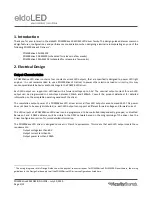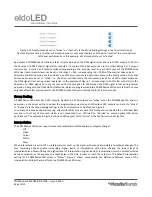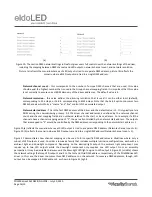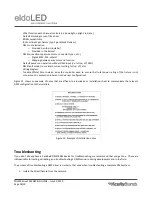
POWERdrive 50W DESIGN GUIDE
–
July 30, 2020
Page 14/19
NTC throttling temperature
The POWERdrive LED driver can monitor the temperature of an external 47k
Ω
NTC thermistor that is connected to the
LEDcode / NTC terminals. Whenever the NTC temperature exceeds the NTC throttling temperature specified in the Control
section of FluxTool, the output current to all LED outputs is immediately decreased to 25% of the actual current. For
example, by placing the NTC on the LED light engine, the POWERdrive LED driver can prevent overheating of the LED light
engine in case it gets accidentally disconnected from its heatsink.
The default NTC throttling temperature is 70 °C but is ignored when no NTC is connected to the LEDcode / NTC terminals.
Power Scaling
The POWERdrive LED driver includes an overpower protection circuit that prevents the LED driver from delivering more
power than its maximum output power rating. When triggered, the overpower protection circuit turns off the LED driver,
resulting in loss of light, which, in most lighting applications, is undesirable. Power Scaling offers a more graceful way to
limit / scale back the output power of a POWERdrive LED driver. Power Scaling is enabled via firmware in the POWERdrive
LED driver and can be configured in FluxTool.
To illustrate the concept of Power Scaling, consider a 50W POWERdrive LED driver that is connected to 4 LED loads, each
with a forward voltage of 50V. To prevent the overpower circuit from kicking in, the cumulative output current across all
LED outputs cannot exceed 1000mA. Assuming equal loading across all LED outputs, the maximum allowable drive current
per LED output, I
fmax
, depends on the number of LED outputs that are on at any one time:
# LED outputs that are on
I
fmax
1
1000mA
2
500mA
3
333mA
4
250mA
The controller in a DMX network is typically not setup to enforce the absolute maximum output power for each LED
driver. Moreover, in most (full color) lighting applications it will be difficult to predict a-priori how many LED outputs will
be on at any one time. Consequently, the safest choice in the example above is to set the drive current for each LED
output to 250mA. However, this results in the LED driver being underutilized, i.e. the LED driver yields significantly less
power than what it is capable of delivering, which, in turn, may drive up the cost of an installation as more LED drivers
Figure 9: Examples of the available interpolation methods in a POWERdrive LED driver.




































